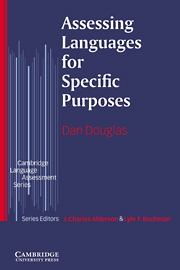Book contents
- Frontmatter
- Contents
- Series editors' preface
- Acknowledgements
- 1 Why test language for specific purposes?
- 2 Specific purpose language ability
- 3 Context, discourse domains, and task characteristics
- 4 Strategic competence: between knowledge and context
- 5 From target language use to test tasks
- 6 Specific purpose tests of listening and speaking
- 7 Specific purpose tests of reading and writing
- 8 LSP test development and technology
- Appendix: other LSP tests
- References
- Index
3 - Context, discourse domains, and task characteristics
Published online by Cambridge University Press: 03 May 2010
- Frontmatter
- Contents
- Series editors' preface
- Acknowledgements
- 1 Why test language for specific purposes?
- 2 Specific purpose language ability
- 3 Context, discourse domains, and task characteristics
- 4 Strategic competence: between knowledge and context
- 5 From target language use to test tasks
- 6 Specific purpose tests of listening and speaking
- 7 Specific purpose tests of reading and writing
- 8 LSP test development and technology
- Appendix: other LSP tests
- References
- Index
Summary
Introduction
As I proposed in Chapter 1, in specific purpose language testing, we want to make inferences about individuals' abilities to use language in specific academic, professional, or vocational fields on the basis of their performance on a language test in which the characteristics of tasks in the target language use (TLU) situation, or context, are incorporated into the test tasks. Clearly, to produce such tests, we need an understanding, first, of the context and tasks in the specific field we are interested in, and second, of how to translate these features into test tasks. In this chapter I will first discuss the notion of context in language use, what I mean by the term, and what features characterize it. Next, I will consider the interesting idea that contexts change all the time – sometimes several times in a few minutes – so we need to understand how it is that we recognize contexts and how we signal to each other that a change is about to take place. Then, I will discuss the notion that what really matters in working with contexts is not so much what the external, situational features of them might be, but how language users interpret contexts. In Chapter 2 I discussed strategic competence, and in this chapter we will see how the external context is internalized by our strategic competence to engage a discourse domain, a key concept in specific purpose language use. Next, I will come to the nub of the matter: the elaboration of a framework for describing tasks in both the specific purpose TLU situation that we are interested in and the specific purpose language test we wish to develop.
Information
- Type
- Chapter
- Information
- Assessing Languages for Specific Purposes , pp. 41 - 74Publisher: Cambridge University PressPrint publication year: 1999
